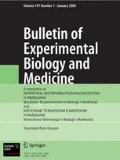We propose a new approach to optimization of electrical stimulation of the vestibular nerve and improving the transfer function of vestibular implant. A mathematical model of the vestibular organ is developed based on its anatomy, the model premises, 3D-analysis of MRI and CT images, and mathematical description of physical processes underlying propagation of alternating electric current across the tissues of vestibular labyrinth. This approach was tested in vitro on the rat vestibular apparatus and had been examined anatomically prior to the development of its mathematical model and equivalent electrical circuit. The experimental and theoretical values of changes of the gain—phase characteristics of vestibular tissues in relation to location of the reference electrode obtained in this study can be used to optimize the electrical stimulation of vestibular nerve.
Similar content being viewed by others
References
Voropayeva OF, Shokin YuI. Numerical simulation in medicine: formulations of the problems and some results of calculations. Vychislit. Tekhnol. 2012;17(4):29-55. Russian.
Demkin VP, Shchetinin PP, Mel’nichuk SV, Kingma G, van de Berg R Pleshkov MO, Starkov DN. Propagation of electric current in tissues of human vestibular labyrinth: improvement of vestibular implant. Izv. Vuzov. Fizika. 2017;60(11):152-157. Russian.
Zuev AL, Sudakov AI, Shakirov NV. Identical the electric model of biological objects. Ross. Zh. Biomekh. 2014;18(4):491-497. Russian.
Kotova AB, Kiforenko SI, Belov VM. Mathematical modeling in biology and medicine. Kibernetika Vychislit. Tekhnika. 2013;(174):47-55. Russian.
Nikolaev DV, Smirnov AV, Bobrinskaya IG, Rudnev SG. Bioimpedance Analysis of Body Composition. Moscow, 2009. Russian.
Bradshaw AP, Curthoys IS, Todd MJ, Magnussen JS, Taubman DS, Aw ST, Halmagyi GM. A mathematical model of human semicircular canal geometry: a new basis for interpreting vestibular physiology. J. Assoc. Res. Otolaryngol. 2010;11(2):145-159.
Gong W, Merfeld DM. Prototype neural semicircular canal prosthesis using patterned electrical stimulation. Ann. Biomed. Eng. 2000;28(5):572-581.
Lionheart W, Polydorides N, Borsic A. The reconstruction problem. Electrical Impedance Tomography: Methods, History and Applications. Holder DS, ed. Manchester, 2004. P. 3-62.
Lloret-Villas A, Varusai TM, Juty N, Laibe C, Le NovÈre N, Hermjakob H, Chelliah V. The impact of mathematical modeling in understanding the mechanisms underlying neurodegeneration: evolving dimensions and future directions. CPT. Pharmacometrics Syst. Pharmacol. 2017;6(2):73-86.
Ramos Miguel A, Ramos Macías A, Viera Artiles J, Perez Zaballos MT. The Effect of Reference Electrode Position in Cochlear Implants. J. Int. Adv. Otol. 2015;11(3):222-228.
Santos C.F, Belinha J, Gentil F, Parente M, Jorge RN. An alternative 3D numerical method to study the biomechanical behavior of the human inner ear semicircular canal. Acta Bioeng. Biomech. 2017;19(1):3-15.
van de Berg R, Guinand N, Nguyen TA, Ranieri M, Cavus-cens S, Guyot JP, Stokroos R, Kingma H, Perez-Fornos A. The vestibular implant: Frequency-dependency of the electrically evoked vestibulo-ocular reflex in humans. Front. Syst. Neurosci. 2015;8:255. doi: https://doi.org/10.3389/fnsys.2014.00255.
Author information
Authors and Affiliations
Corresponding author
Additional information
Translated from Byulleten’ Eksperimental’noi Biologii i Meditsiny, Vol. 164, No. 12, pp. 671-676, December, 2017
Rights and permissions
About this article
Cite this article
Demkin, V.P., Udut, V.V., Shchetinin, P.P. et al. Electrophysiological Properties of Rat Vestibular Labyrinth and Their Effect on Parameters of Transmitted Voltage Pulses. Bull Exp Biol Med 164, 707–711 (2018). https://doi.org/10.1007/s10517-018-4063-4
Received:
Published:
Issue Date:
DOI: https://doi.org/10.1007/s10517-018-4063-4


